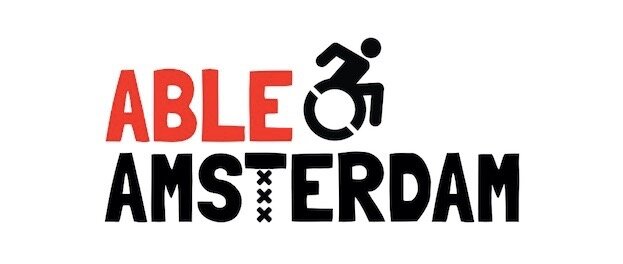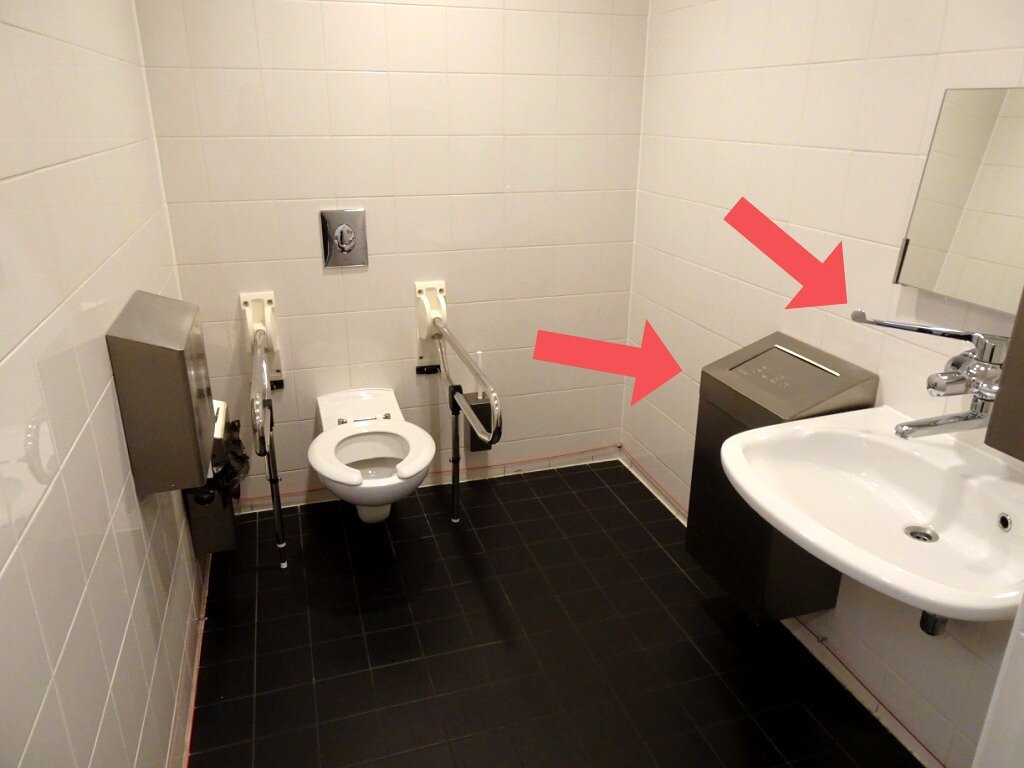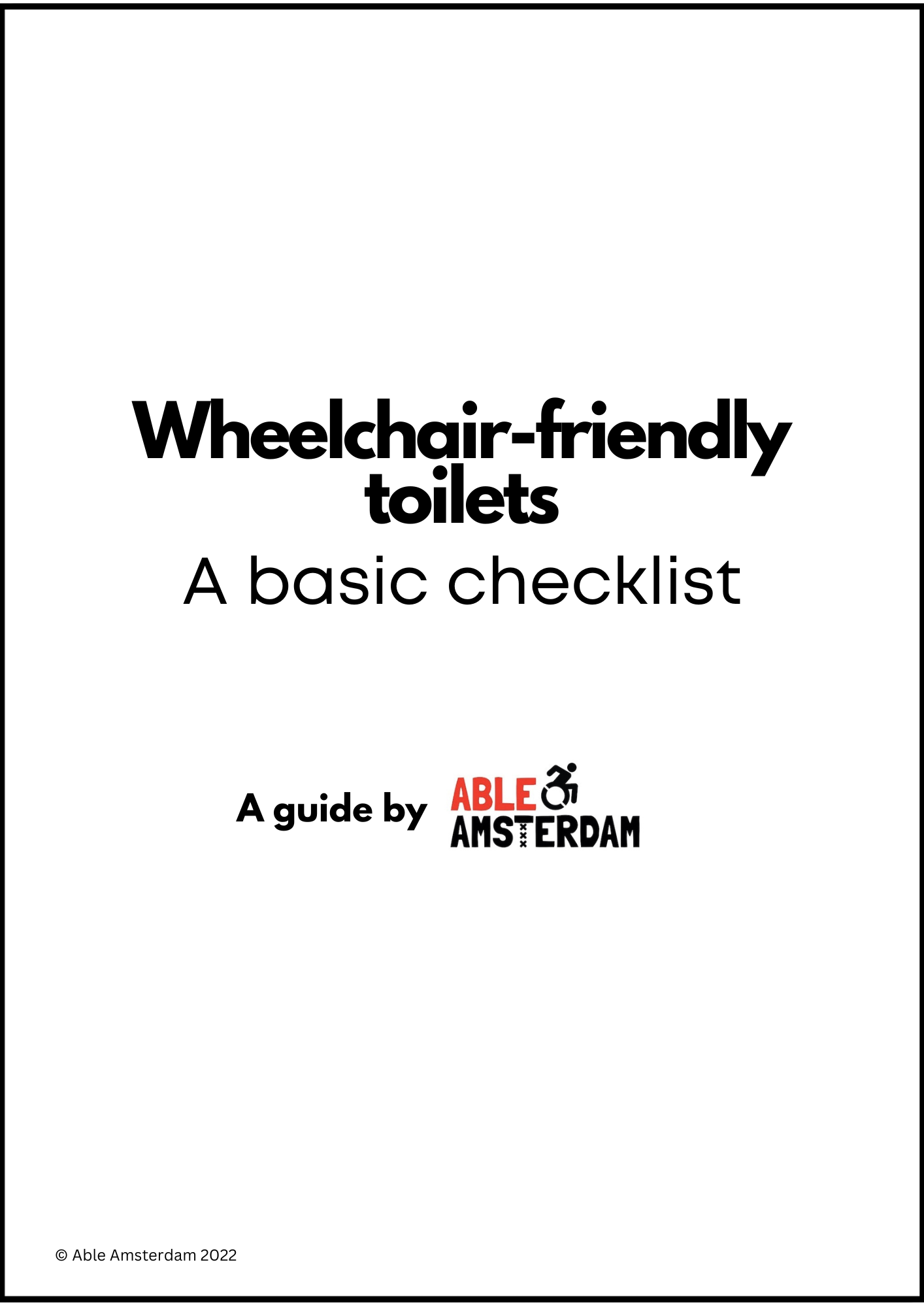What makes a toilet accessible? Important features of a wheelchair-friendly loo
Disclaimer: I am not a professional when it comes to the specifications for accessible toilets. However, based on personal experience as a mobility aid user, I consider the criteria below important. The information in this post should serve as a guide in combination with advice from an expert in this field.
Accessible toilets are an absolute necessity for many people living with a disability. A crucial part of inclusive spaces, their design features allow wheelchair users and individuals with a range of (physical) disabilities to use the toilet as independently and safely as possible.
I’ve seen a lot of “wheelchair-friendly” toilets around Amsterdam. The lack of regulations in The Netherlands means these toilets come in all shapes, sizes, and degrees of accessibility. Worst case scenario –bursting for the loo — I’ve rolled into “accessible” toilets to find nothing more than a standard cubicle on the ground floor. Establishments with the best intentions often interpret “accessible” to mean “ground floor” and “step-free“. But it’s so much more than that.
But first: Who are accessible toilets for?
Wheelchair users
Individuals with mobility impairments
People with bowel and/or bladder conditions
People with balance issues, grip issues, or other conditions that make support rails useful
People with a range of invisible disabilities who also need to use the facilities
… and more
Here are my top 10 important features of a wheelchair-friendly toilet:
1. An accessible door(way)
Doorways of accessible toilets should be wider than normal (min. 80 cm / 32 inches) so that wheelchair users can easily roll in and out. There should be no threshold obstructing the entrance. The door should be lightweight so that it opens with minimal force (believe me, it’s hard to juggle a mobility aid with a heavy door). To easily close the door behind you, there should be a horizontal grab bar along the inside of the door. In addition, the door should always open outwards. This means the door can still be opened easily in an emergency situation if someone has fallen on the toilet floor.
2. Grab rails
Adjustable grab rails inside Hotel Sofitel Legend The Grand, Amsterdam
Grab rails are a basic feature of any accessible toilet. They provide crucial support, stability and balance for anyone transferring onto the toilet. Without them, I’d have to hold onto the toilet seat (yuck!) which is as unhygienic as it is unsafe.
3. A raised toilet seat
For people with reduced mobility like myself, higher toilet seats make it easier to stand up and sit down. By raising the seat of an accessible toilet, transfers to/from a wheelchair are also safer as the seat height is more equal between the two.
4. Low mirrors and sinks
A low mirror and sink at the OBA Public Library (Oosterdokskade)
Mirrors and sinks in accessible toilets should be placed at a lower height. This makes them useable for anyone seated in a wheelchair.
5. The soap, paper towels, hand dryer, hooks, and toilet paper must all be within reach when seated
The soap, paper towels and toilet paper are all within reach for wheelchair users at the Hyatt Regency Amsterdam
All amenities in an accessible toilet must be within reach for wheelchair users. This means placing or hanging things at a lower height than in standard toilets.
Any paper towels or hand dryers should also be placed close to the sink. This way mobility aid users won’t have to touch their wheelchair, rollator, or crutches with wet hands as they go to dry them off.
6. Easy-to-use tap and bin designs
Easy-to-use taps and bins at the OBA Public Library at Oosterdokskade
The tap in an accessible toilet should be an easy-to-use design that doesn’t require much force. Especially as some disabilities involve difficulty gripping things, the tap should be useable with a closed fist. For this reason, a lever design (see photo above) is much better than a tap with a twistable knob.
Similarly, bins should be easily operated without much force and with a closed fist (see photo above). Foot-pedal bins are a big no no, as anyone with limited or no leg function would find them impossible to use. It’s also important that bins are large enough for multiple users to discreetly dispose of (adult) diapers, stoma bags, or other waste items.
7. Space
A spacious accessible toilet inside the Hotel Okura in Amsterdam
An accessible toilet has to be spacious enough to turn and manoeuvre in a wheelchair. At minimum, this should involve a clear and unobstructed wheelchair turning circle of 1.5 metres in diameter. Ideally there should be space on both sides of the toilet (min. 90 cm) so that wheelchair users can transfer onto the toilet seat from either side. The sink should also have adequate space underneath to roll right up to it in a wheelchair.
Remember that the extra space in an accessible toilet is a necessity, not a luxury. It shouldn’t be used as a storage cupboard, filing cabinet, laundry room, or anything else.
8. An emergency alarm cord
A bright red emergency cord at the Van der Valk Hotel Amsterdam-Amstel
Every accessible toilet needs an emergency alarm cord. This ensures that anyone who falls or needs assistance can signal for help.
Emergency alarm cords should be hung approx. 40 cm from the ground around the full parameter of the toilet. The button to turn off the alarm should also be inside the toilet, so an alerted staff member always has to enter the toilet (and check on anyone inside) before turning it off.
9. Signposting
Stylish signposting at Persijn in the QO Amsterdam
If you’ve got an accessible toilet, flaunt it! Signposting with a wheelchair icon is especially important so anyone in need of an accessible toilet knows it exists and knows where to find it.
10. Changing Places Facilities
Finally, the best accessible toilets also have Changing Places Facilities. These are specialised toilet facilities for people with more complex needs who are unable to use a standard toilet. It includes a tracking hoist system, an adult sized changing bed, and other features that allow individuals to use the toilet with comfort and dignity. For more details, please see the official Changing Places website.
Final tip: accessaloo, an app putting wheelchair-friendly loos on the map
accessaloo is a new app (2019) that allows users to share information and locate accessible toilets around the globe. Click here to go to the accessaloo website, or download the app directly from the App Store or Google Play.
Free Downloadable PDFs
Able Amsterdam has a variety of free downloadable PDF documents about wheelchair accessibility. Click on the image below for a free summary of this blog post:










